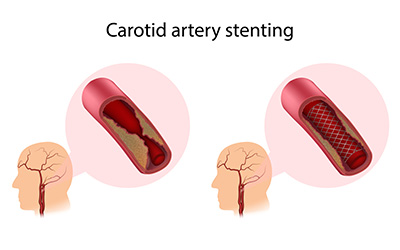The carotid arteries are located on each side of your neck and provide the main blood supply to the brain. Carotid artery disease occurs when fatty substances called plaque build up in a carotid artery. The plaque may block or narrow the carotid artery or cause a clot to form. The blockage increases your risk for stroke, a medical emergency that occurs when the brain losses all or much of its blood supply.
Carotid Artery Disease Risk Factors
Risk factors for blockage or narrowing of the arteries include:
- High blood pressure
- Diabetes
- Heart disease
- High cholesterol
- Heavy tobacco (smoking) or alcohol use
- Kidney disease, especially when dialysis is needed
- Obesity
- Family history of stroke
- Increasing age
Two uncommon conditions, Marfan syndrome and fibromuscular dysplasia (abnormal growth or development of the cells in the walls of carotid arteries), may also cause narrowing of the carotid arteries.
Symptoms of Carotid Artery Disease
In its early stages, carotid artery disease often doesn’t have symptoms. The condition might not become obvious until a person has signs of a stroke or TIA. A TIA is a temporary shortage of blood flow to the brain that does not cause permanent damage. Symptoms of a stroke or TIA include:
- Sudden numbness or weakness in one part of the body
- Blurred vision in one or both eyes
- Confusion
- Loss of memory
- Problems with speech and language
- Dizziness or loss of balance
- Sudden, severe headache with no known cause
Carotid Artery Disease Treatment Options
Treatment of carotid artery disease usually involves lifestyle changes and/or medicine to lower cholesterol and control blood pressure with the goal of preventing stroke. However, factors such as how blocked the carotid artery is, whether the blockage is causing symptoms, and a person’s age are considered in treatment decisions.
Yearly imaging tests of the carotid arteries can help assess the effectiveness of treatment. Blood-thinning medications may also be used to lower the risk of stroke. Sometimes surgery is determined to be the best option for treatment of the disease.
-
Carotid Endarterectomy
 Carotid endarterectomy is a surgical procedure often used to treat severe carotid artery disease. During surgery, plaque buildup in the carotid arteries is removed to help prevent a stroke from occurring when there is a large blockage. After cutting along the front of the neck, the blocked artery is opened and then repaired with stitches or a graft.
Carotid endarterectomy is a surgical procedure often used to treat severe carotid artery disease. During surgery, plaque buildup in the carotid arteries is removed to help prevent a stroke from occurring when there is a large blockage. After cutting along the front of the neck, the blocked artery is opened and then repaired with stitches or a graft. -
Carotid Stenting
 When a blockage is too hard to reach or other health conditions make carotid endarterectomy too risky, a stent may be placed in the artery. A tube, known as a catheter, is used to send a tiny balloon to the area of the clog. The balloon is inflated to widen the artery and a small wire mesh coil, or stent, is put in to keep the artery from narrowing again.
When a blockage is too hard to reach or other health conditions make carotid endarterectomy too risky, a stent may be placed in the artery. A tube, known as a catheter, is used to send a tiny balloon to the area of the clog. The balloon is inflated to widen the artery and a small wire mesh coil, or stent, is put in to keep the artery from narrowing again. -
Transcarotid Artery Revascularization (TCAR)
TCAR is a unique minimally invasive procedure that enables blood flow to be temporarily reversed so that any bits of plaque that may break off during surgery are diverted away from the brain.
The procedure is performed through a small incision at the neckline just above the clavicle (collarbone). A tube is placed into the carotid artery and connected to a system that directs blood flow away from the brain. This filtered blood is then returned through a second tube in the upper leg. A carotid stent is then placed to stabilize the plaque in the affected artery. After successful placement, flow reversal is turned off and blood flow resumes in its normal direction.
Learn more about stroke and neuroscience services at Texas Health.
Sources:
Society for Vascular Surgery
Mayo Clinic

